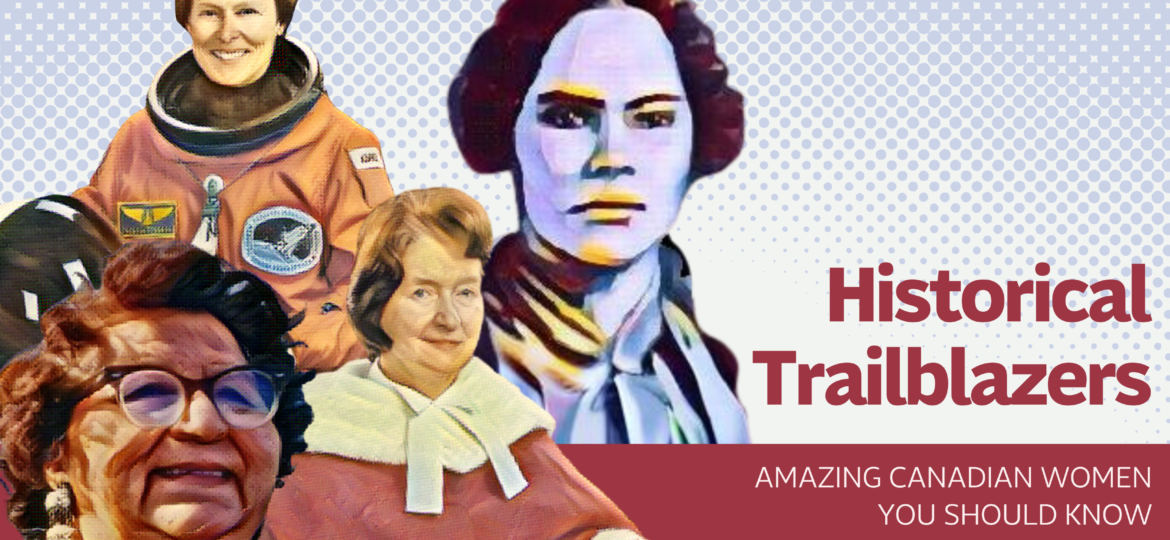
Amazing Canadian women you should know
Author: Emily Mathison
We’re taking you back to school in this piece to learn about some of the badass women who forged their way through Canadian history. These are the women we want to be when we grow up.
Roberta Bondar (1945 – Present)
Roberta Bondar is not necessarily a historical Canadian woman (she’s still kicking) — but as the first Canadian female astronaut, we would be remiss to not include this stellar pioneer.
Most known for: Canada’s first female astronaut and the world’s first female neurologist in space.
Roberta dreamed of being an astronaut from childhood. And while many children do, this aspiration was seriously encouraged by her father. In his basement lab she was free to perform experiments and explore her scientific curiosities.
In high school, Roberta’s guidance counsellor discouraged her from pursuing science in post-secondary, saying it “wasn’t a subject for girls” — *eye roll*. Despite that, Roberta went on to obtain many degrees, ranging from a bachelor of science in zoology and agriculture, and masters of science in experimental pathology, to two doctorates, one in neuroscience and the other in medicine. Pretty impressive for a girl!
In 1992, Roberta’s dream of being an astronaut was realized aboard the NASA Space Shuttle, making her the first Canadian female astronaut and first neurologist in space. Following that mission, Roberta continued her career as a pioneer in space medicine. Her research drew important new links between how the body recovers from the lack of gravity in space to neurological diseases like Parkinson’s disease.

Her 2023 Twitter bio: Roberta actually has a Twitter bio: “World’s First Astronaut Neurologist, Professional Landscape & Avian Photographer, Writer, MD PhD”–but we are going to take the liberty to spice it up!
Mary Two-Axe Earley (1911 – 1996)
Most known for: Indigenous rights activist, Indigenous Elder, women’s rights activist.
Beyond having probably the most kick-ass surname, Mary Two-Axe Earley, was an indigenous rights activist who famously fought for corrections to gender discrimination under the Indian Act.
She was born Mary Two-Axe on the Mohawk (Kanien’kehá:ka) reserve of Kahnawake, Quebec. At the age of 18, she moved to Brooklyn, New York and a few years later married an Irish American, Edward Earley. At that time, the Indian Act dictated that by marrying a non-status man, a woman was stripped of her legal Native status and treaty rights.
This left Mary unable to participate in her indigenous community. She lost the right to own the land she was set to inherit on her ancestral lands, she could not participate in her band’s politics, she could not be buried on the reserve, and her future children would also face these discriminations.
Mary wouldn’t stand for it. “I was angry since I observed the devastating effects of this policy on so many women,” she said. She spent decades fighting for the fact that a woman’s principle is not defined by her husband. Eventually, in 1985, when Mary was 73 years old, Bill C-31 was established. This amendment addressed gender discrimination in the Indian Act and outlined a process for reinstating lost status, helping many other women regain their rights.
Justice Bertha Wilson (1923 – 2007)
Most known for: First female Justice of the Supreme Court of Canada, contributed to many important decisions for women’s rights in areas of discrimination, self defence for battered women, and abortion rights.
Bertha Wilson was strong in her convictions and not the meek woman you might picture when imaging a minister’s wife and school teacher in the 1950s. When Bertha applied to Dalhousie’s Law School in 1954, the Dean was skeptical and quipped, “why don’t you just go home and take up crocheting?” (Again, *eye roll*).
But Bertha was always a trailblazer and a woman of firsts. She started off her career in law as the first female lawyer in a major Canadian law firm, before becoming its first female partner. Following that, she was the first woman appointed to the Ontario Court of Appeal. And finally, Bertha was the first woman appointed to the Supreme Court of Canada.
On the Supreme Court, Bertha wrote judgement over many landmark decisions including R. v. Lavallée which established battered-wife syndrome as valid self-defense to murder. She also authored a momentous decision which stuck down Canada’s ban on abortion based on a woman’s right to choose.
Notably, Bertha wrote a controversial paper, Will Women Judges Really Make a Difference, where she argues that seemingly equal laws do not contain a female perspective and are often, at their core, discriminatory towards women. She concludes by saying, “If women lawyers and women judges through their differing perspectives on life can bring a new humanity to bear on the decision-making process, perhaps they will make a difference. Perhaps they will succeed in infusing the law with an understanding of what it means to be fully human.”
Fully human, as in acknowledging both genders. Amen to that, Bertha.

Mary Ann Shadd (1823 – 1893)
Most known for: Early Canadian-American entrepreneur, anti-slavery activist, first female newspaper founder and editor in North America, teacher, lawyer.
Mary Ann Shad was born in Wilmington, Delaware as a free person. But after the Fugitive Slave Act passed in the United States in 1850, Mary Ann and her family moved north to Canada where they could access more freedoms.
It was here that Mary Ann hit the business world and became the token Dragon’s Den female of her time. She founded an integrated school and launched an anti-slavery newspaper, making her the first women in North America to own and edit a newspaper.
Mary Ann’s newspaper, the Provincial Freeman, promoted equal rights for Black people and women. It’s slogan: Self-reliance is the true road to independence. Mary Ann lived this motto by encouraging other Black people to advocate for their equal rights and for the abolition of slavery.
But she wasn’t done trailblazing there – Mary Ann went on to be the first African American woman to attend Howard University’s law school and practiced law until the end of her career.
During Women’s History Month, we’ve had the privilege of delving into the incredible lives of these pioneering Canadian women. From astronauts to activists, each one left an indelible mark on history, pushing the boundaries of what was possible in each of their own contexts.
Their stories remind us that progress is not a single leap but a journey filled with resilience, determination and an unwavering belief they could make a difference. The impact of these trailblazing Canadian women resonates today, encouraging us to stand up for what is right, pursue our dreams, and, above all, to never underestimate the power of a single individual to spark positive change in the world.
As we celebrate Women’s History Month, let’s remember the enduring legacy of these remarkable women. Their stories remind us that change is driven by individuals who dare to challenge the status quo. They inspire us to stand up, pursue our dreams, and embrace the power we hold to create positive change in the world. Let their journeys be a source of inspiration as we continue to write history and honour their enduring impact.



